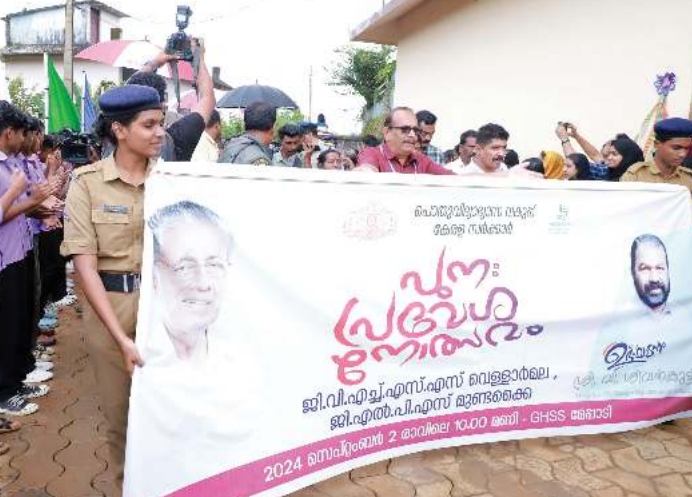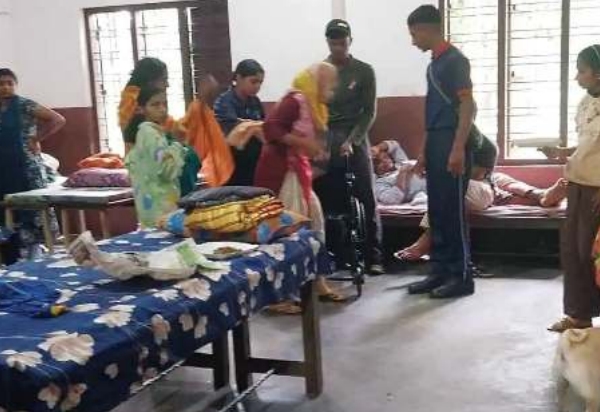Resilient and Sustainable Rebuilding

 At the outset, the Government of Kerala extends its heartfelt gratitude to the rescue teams, armed forces, volunteers, and countless individuals and organisations who had come forward to assist in the rescue, recovery and relief efforts. Their dedication and tireless work have been instrumental in saving lives, providing comfort, and bringing hope to the affected. It is because of their selfless actions that we have been able to begin the process of rehabilitation and rebuilding in record time. Within just weeks of the disaster, we have been able to provide temporary rehabilitation for all affected families. A total of 795 families, comprising 2,569 individuals, were accommodated in temporary camps. Rental houses and government facilities in Vythiri taluk have been made available to ensure transitory accommodation for them. Financial assistance has been given to those who returned to their relatives’ homes, with 543 families receiving aid through self-certification. A monthly rent of ₹6,000 is being provided to them and those in rented accommodation. “Back to Home” kits which included essential household items were distributed to 583 families. In the initial phase, immediate financial aid of ₹10,000 was provided to 821 affected families.
At the outset, the Government of Kerala extends its heartfelt gratitude to the rescue teams, armed forces, volunteers, and countless individuals and organisations who had come forward to assist in the rescue, recovery and relief efforts. Their dedication and tireless work have been instrumental in saving lives, providing comfort, and bringing hope to the affected. It is because of their selfless actions that we have been able to begin the process of rehabilitation and rebuilding in record time. Within just weeks of the disaster, we have been able to provide temporary rehabilitation for all affected families. A total of 795 families, comprising 2,569 individuals, were accommodated in temporary camps. Rental houses and government facilities in Vythiri taluk have been made available to ensure transitory accommodation for them. Financial assistance has been given to those who returned to their relatives’ homes, with 543 families receiving aid through self-certification. A monthly rent of ₹6,000 is being provided to them and those in rented accommodation. “Back to Home” kits which included essential household items were distributed to 583 families. In the initial phase, immediate financial aid of ₹10,000 was provided to 821 affected families.
A sum of Rs. 8 lakh each has been distributed to 93 families who lost their loved ones, sourced from the State Disaster Response Fund (Rs. 4 lakhs), Chief Minister’s Distress Relief Fund (Rs. 2 lakhs), and the Prime Minister’s National Relief Fund (Rs. 2 lakhs). Up to Rs. 1,00,000 (Rs. 50,000 each from CMDRF and PMNRF) has been granted to those with serious injuries. Rs. 10,000 was sanctioned for the funeral ceremonies of 173 families. Emergency aid was provided to 1,259 families at a rate of Rs. 300 per day for each person. Two persons per family are eligible for the aid, ensuring that a family could get up to Rs. 10,000 per month. The draft list of missing persons was first published as an initial step to find them. This draft list was published based on documents such as ration cards, ID cards, voters’ lists, various passbooks, and educational records. Within six days of the disaster, a draft list of 131 individuals was released. Information was extracted from this list, and the details of those identified were removed before publishing the second list, which included 120 individuals. As part of the effort to locate missing persons, DNA testing was conducted on the recovered bodies and body parts. A total of 427 samples from bodies and recovered body parts were subjected to DNA analysis. It was found that the DNA of 21 bodies and 59 body parts matched 42 individuals. The current list of missing persons now has 72 names.
This list is compiled and updated by the District Police Superintendent. To help families recover from the impact of the disaster, the services of over 350 social and mental health counsellors and psychiatrists were ensured. A total of 2,000 individual psycho-social counselling sessions, 21 psychiatric pharmacotherapy sessions, and group counselling sessions for 401 people were conducted. This comprehensive mental health support aims to help the affected individuals to regain their stability and confidence. Rehabilitation efforts will not be limited to Wayanad alone; but will also be extended to those affected in Vilangad, Kozhikode district. Priority in the rehabilitation process will be given to those who have lost their homes. The rehabilitation package will include livelihood support; focus on employment opportunities and training programmes for women to engage in occupations of their choice. Small business owners currently operating in makeshift buildings will also receive support to resume their economic activities. Looking towards long-term solutions, the State Government is committed to build single-storey houses with an area of 1,000 square feet. These houses will have strong foundations to support additional floors.
 This approach will ensure that families have secure and future ready homes, reflecting the State Government’s commitment to sustainable rebuilding. These houses will be constructed uniformly, with assured quality and all necessary public facilities arranged at the rehabilitation sites. The State Government places great importance on education and the future of our youngsters affected by the disaster. A school entry festival is scheduled on September 2nd, and experts will evaluate whether existing schools in disaster-affected areas can be reconstructed and retained. Necessary educational facilities will also be arranged at the rehabilitation sites to ensure uninterrupted learning for all the affected students. The Government Lower Primary School, located amidst the tea plantations of Mundakkai, and Vellarmala High School, previously situated along the riverbank in Chooralmala, no longer exist. However, these two public schools are being revived without changing their names. They are being reopened a little further away in Meppadi.
This approach will ensure that families have secure and future ready homes, reflecting the State Government’s commitment to sustainable rebuilding. These houses will be constructed uniformly, with assured quality and all necessary public facilities arranged at the rehabilitation sites. The State Government places great importance on education and the future of our youngsters affected by the disaster. A school entry festival is scheduled on September 2nd, and experts will evaluate whether existing schools in disaster-affected areas can be reconstructed and retained. Necessary educational facilities will also be arranged at the rehabilitation sites to ensure uninterrupted learning for all the affected students. The Government Lower Primary School, located amidst the tea plantations of Mundakkai, and Vellarmala High School, previously situated along the riverbank in Chooralmala, no longer exist. However, these two public schools are being revived without changing their names. They are being reopened a little further away in Meppadi.
New classrooms were set up swiftly, so that the students’ education is not hindered. Understanding the financial challenges faced by the victims, the Government of Kerala convened the State-Level Bankers’ Committee to explore measures for financial relief, including the possibility of writing off debts. Although the final decision rests with the banks, consultations will be held with the Reserve Bank and the Union Ministry of Finance to ensure comprehensive support. Stern action will be taken against private money lenders trying to recollect their loans, during these troubled times. A special financial package has been requested from the Union Government to aid the rehabilitation and rebuilding efforts. Efforts are underway to strengthen the state’s disaster preparedness and response capabilities. While cyclone warnings are effectively communicated, there is a need for improved alert systems for events like landslides.
 Assistance from National Nodal Agencies has been sought to enhance warning systems, and Kerala’s Climate Change Research Institution is expected to receive additional support from the Union Government Agencies to bolster its capabilities. Aiming to rebuild with resilience to future disasters, the State Government is focussing on long-term reconstruction and rehabilitation. This comprehensive plan involves rebuilding infrastructure, restoring agricultural lands, and supporting the economic revival of the region. Recognising the crucial role of farmers in the local economy, the rehabilitation package will include facilities to help them continue their agricultural activities. Efforts will be coordinated to involve individuals and organisations willing to sponsor rehabilitation initiatives, ensuring a collaborative and effective approach to recovery. In these challenging times, it is important to remember the power of unity and hope. The release of the song “Onnay Neridam, Kanalay Thunayay Keralame Poroo,” sung by K. J. Yesudas, serves to inspire and uplift the spirits of the affected. This song symbolises the resilience and courage of the people of Kerala, encouraging everyone to face adversity together, supporting each other. The Government of Kerala remains unwavering in its commitment to those affected by this terrible natural disaster. Every effort will be made to ensure their well-being. The state will continue to work tirelessly to restore normalcy, rebuild lives, and provide hope for a brighter future. The survivors can be assured that the State Government is with them every step of the way, and together, we will overcome and emerge stronger.
Assistance from National Nodal Agencies has been sought to enhance warning systems, and Kerala’s Climate Change Research Institution is expected to receive additional support from the Union Government Agencies to bolster its capabilities. Aiming to rebuild with resilience to future disasters, the State Government is focussing on long-term reconstruction and rehabilitation. This comprehensive plan involves rebuilding infrastructure, restoring agricultural lands, and supporting the economic revival of the region. Recognising the crucial role of farmers in the local economy, the rehabilitation package will include facilities to help them continue their agricultural activities. Efforts will be coordinated to involve individuals and organisations willing to sponsor rehabilitation initiatives, ensuring a collaborative and effective approach to recovery. In these challenging times, it is important to remember the power of unity and hope. The release of the song “Onnay Neridam, Kanalay Thunayay Keralame Poroo,” sung by K. J. Yesudas, serves to inspire and uplift the spirits of the affected. This song symbolises the resilience and courage of the people of Kerala, encouraging everyone to face adversity together, supporting each other. The Government of Kerala remains unwavering in its commitment to those affected by this terrible natural disaster. Every effort will be made to ensure their well-being. The state will continue to work tirelessly to restore normalcy, rebuild lives, and provide hope for a brighter future. The survivors can be assured that the State Government is with them every step of the way, and together, we will overcome and emerge stronger.


